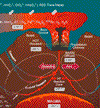Link:
http://www.eurekaler...rbs-1904101.phpHere's a similar 'novel amino acid' article from a few years back...
Public release date: 19-Apr-2001
Contact: Robin B. Goldsmith
rgoldsmi@scripps.edu
858-784-8134
Scripps Research Institute
Simultaneous reports by scientists at the Scripps Research Institute show how they made bacteria do what nature doesn'tLa Jolla, CA, April 20, 2001 – Scientists at The Skaggs Institute for Chemical Biology at The Scripps Research Institute (TSRI), have published two separate papers in the current issue of the journal Science in which they describe two different ways of engineering bacterial cells to encode "unnatural" proteins.
These proteins differ from those produced by other living organisms because they incorporate novel amino acids, the subunit molecules of which proteins are composed.
Both of these methods could provide powerful new mechanisms for studying protein and cellular functions, because they are proof-of-principal that bacterial strains can be made to incorporate novel amino acids into proteins. In addition, they could enable scientists to envision the possibility of engineering completely new proteins.
According to TSRI President Richard A. Lerner, M.D., "One of the holy grails of modern genetics is the extension of the genetic code to increase the ability of proteins to perform new chemical tasks. We at The Skaggs Institute of TSRI are extremely proud to have accomplished this by two separate routes."
Principal Investigators Peter Schultz, Ph.D., Scripps Family Chair, The Skaggs Institute and Department of Chemistry; and Paul Schimmel, Ph.D., Ernest and Jean Hahn Professor and Chair, The Skaggs Institute, and Departments of Molecular Biology and Chemistry, led the two separate efforts.
The research article, "Enlarging the Amino Acid Set of Escherichia coli by Infiltrating the Valine Coding Pathway," is authored by Volker Döring, Henning D. Mootz, Leslie A. Nangle, Tamara L. Hendrickson, Valérie de Crécy-Lagard, Paul Schimmel, and Philippe Marlière.
The research article, "Expanding the Genetic Code of Escherichia coli," is authored by Lei Wang, Ansgar Brock, Brad Herberich, and Peter G. Schultz.
Encoding proteins from DNA is one of the most fundamental requirements for life, since proteins do much of the microscopic work of the cell and make up a large part of the physical structure of cells and tissue.
When a protein is expressed, an enzyme reads the DNA bases of a gene (A,G,C, and T), and transcribes them into RNA (A, G, C, and U). This so-called "message RNA" is translated by another enzyme, called the ribosome, into a protein, which is a chain of amino acids. For every codon on the mRNA—every three bases—the ribosome attaches another amino acid to the chain.
But even though there are 4x4x4 = 64 different codons (UAG, ACG, UTC, etc.) there are only 20 amino acids that all organisms use to produce proteins. One of the great unanswered questions of evolutionary biology is why there are only 20.
Some of the 64 codons are redundant, with several coding for the same amino acid, and a few of them are nonsense codons—they don't code for anything at all.
Schultz and his colleagues have developed a general method to make the bacterium Escherichia coli incorporate novel amino acids site-specifically.
Their approach starts with generating an orthogonal transfer RNA/synthetase pair, which does not interact with other pairs existing in E. coli.
Then the orthogonal synthetase was engineered so that it charges the orthogonal tRNA with an unnatural amino acid but not any natural amino acids.
The orthogonal tRNA delivers the attached novel amino acid into proteins in response to a UAG codon inserted at any position of interest.
Using this method, they have incorporated O-methyl-L-tyrosine into proteins with purity higher than 99 percent, which is close to the translation fidelity of natural amino acids.
Schimmel and his colleagues used a more general approach, which broadly incorporates the novel amino acid aminobutyrate into proteins where the amino acid valine should go. To do this, they modified the valine tRNA synthetase enzyme.
Using mutagenesis and screening, they were able to find a valine tRNA synthetase with no proofreading mechanism. In this mechanism, another part of the enzyme checks to see if it accidentally attached an aminobutyrate to a tRNA where it should have attached a valine.
Though aminobutyrate and valine are almost identical, the proofreading mechanism is highly specific, allowing fewer that one mistake in 100,000 tries.
But the proofreading mutants are so good at making mistakes that in their paper, Schimmel and his colleagues report that 24 percent of all the valines are randomly replaced with aminobutyrates.
These strange new proteins can then be purified and studied in isolation, or left in vivo and used as a probe to study cellular functions.
Furthermore, proteins with novel amino acids may prove to have enhanced or emergent properties. Having a bacterial expression system will make them trivial to produce on a massive scale.
###
The research was funded by The Skaggs Institute for Research, National Institutes of Health, National Foundation for Cancer Research, and the Office of Navy Research.
(A "Perspectives" piece on this work will be published in Science magazine and is available by contacting Ginger Pinholster, AAAS, 202-326-6440.)
 NOAA:: Chemical Oceanography:: Hydrothermal Vent Geochemistry::
NOAA:: Chemical Oceanography:: Hydrothermal Vent Geochemistry::



















































